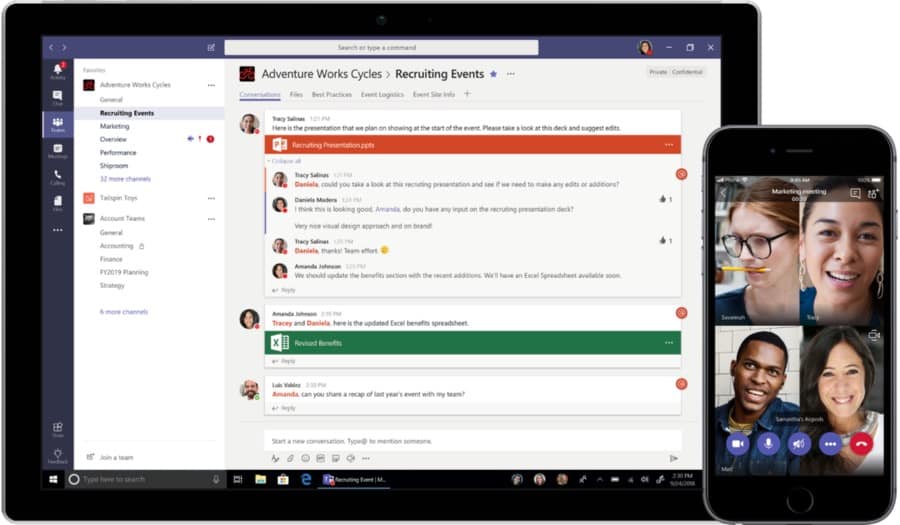
Above: Microsoft’s Teams collaboration tool is now available for general use at no cost. Image courtesy Microsoft.
BitDepth#1154 for July 19, 2018
At a media preview of new products last week, Microsoft put a clear and definitive stamp of authority on its cloud product, Azure.
The product and services lineup was announced at Inspire 2018, a partner event held this week in Las Vegas.
The company’s refocused profile for business services, the cloud-driven Microsoft 365, rolls all its products, from Windows 10 and Office 365 into considerable enterprise, mobility and security systems powered by Azure’s distribution, storage and infrastructure across a range of platforms and software engines.

Microsoft’s Whiteboard digital collaboration space is also available at no cost to Windows users. Image courtesy Microsoft.
Introduced in February 2010, Azure has grown from much humbler beginnings as a cloud service into the backbone of Microsoft’s presence in business.
Those services are a clever mix of proprietary software running the cloud software with an open source approach to providing software development kits (SDKs) and application programming interfaces (APIs) for developers to integrate their products.
Year over year, Microsoft 365 has doubled its customer base, with the more mature Azure product delivering a 90 percent increase in business.
“Azure,” Jason Zander, executive vice-president for the cloud service declared, “is on a winning streak.”
The company introduced wider access to the Azure Data Box Disk, an SSD based device designed to speed the transfer of up to 35TB of data introduced in 2017 for the US. The device is currently in preview in Europe and the United Kingdom.
Not content to tout the market leading speed of its SQL database product and a doubling of query performance, Microsoft is offering special pricing for users of Windows Server and SQL Server 2008/2008 R2, which hits end of life in one year.
Users who migrate will get three years of Extended Security Updates for free and can make use of an Azure SQL Database Managed Instance (available Q4 this year) which will move existing Windows and SQL server installations to Azure with no application code changes and “near zero downtime.”
Azure Stack is also available as a hybrid cloud solution. The next generation SQL Server links with Azure with greater query performance and deeper links with Microsoft’s Power BI business intelligence analysis tools.
“There’s a clear shift from individual productivity to dynamic teamwork,” said Zander, “to systems that enable seamless workflow in teams.”
Microsoft’s Teams product, a cloud-based collaboration tool that competes with Slack, Blizz and Zoho Cliq is now available for free.

My Analytics gathers information about work and collaborators in Microsoft 365. Image courtesy Microsoft.
The free Teams targets SME’s with unlimited chat, search and app integrations, audio and video calling and 10GB of storage for teams with an additional 2GB for each team member. The product is available immediately in 40 languages globally.
Before last week, you needed a license for Office 365 to use Teams, now you can work with other apps that integrate with it.
Teams is in use by 200,000 companies and integrates with 140 productivity apps.
Microsoft 365 adds new event capabilities, allowing for more face to face collaboration between team members who aren’t in the same room.
One clever feature blurs the background in a participant’s video feed, while more practical new features include speech transcription, time coding, closed captions and a recording feature which allows latecomers or absentees to review the meeting from the start.
The productivity platform also adds a shared whiteboard space (also available for free) that allows collaboration between any devices that support Microsoft 365 and at least one feature that I’m predicting is going to be wildly unpopular, a nudge feature that’s meant to encourage team collaborators to meet targets using workspace analytics.



